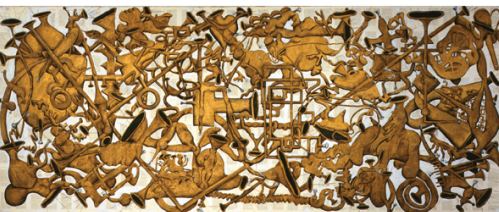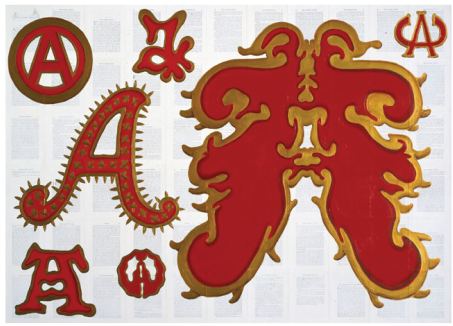The art world is always saying next, please. I’m bored with your dead tiger shark and live nudes, your singing museum guard and your fallen Pope. The shark that is never dead is the art world itself, which, as Woody Allen explained in Annie Hall, has to keep moving to stay alive.
Those who work in that world shovel the present into the past as a kind of necessary clean-up. For market reasons disguised as aesthetics, key power players determine who among the previously celebrated remains a live wire. The rest will be regulated to the heap of has-beens, to be humiliated and disappeared. Only live wires make the market hum.
Even as they rose like surface to air missiles to art world’s stratospheres, Tim Rollins and K.O.S. lived with an undertow of detractors, those who thought somebody was being exploited here and it could well be them for taking this project seriously.
How could it be taken seriously? The odds against it are impossible.
 In 1981, when collectors were drinking pink champagne out of glass slippers at the Mary Boone Gallery, a serious student of the Rev. Martin Luther King Jr., John Dewey and Joseph Kosuth stepped off the subway in the South Bronx to the smell of the burning garbage.
In 1981, when collectors were drinking pink champagne out of glass slippers at the Mary Boone Gallery, a serious student of the Rev. Martin Luther King Jr., John Dewey and Joseph Kosuth stepped off the subway in the South Bronx to the smell of the burning garbage.
From James Romaine, an essay in the catalog for Tim Rollins and K.O.S – A History:
Rollins
walked the four-and-a-half blocks to the school through a decimated
landscape of burnt-out buildings and vacant lots strewn with trash and
urban rubble, roamed by packs of wild dogs, with the remains of
Santeria animal sacrifices in front of crack houses. He also saw
mothers walking their children to school.
His job
became teaching art in special education classes at I.S. 52. Special
education, in this case, turned out to be a dumping ground for
discipline problems and dyslectics. One of the reasons there are so few
girls in the K.O.S. relates to this original structure. Discipline
problems are boys, and so are dyslectics. Once Rollins was established,
the dumping ground premise still operated for educators making
referrals. The students who were failing their classes but drew
imaginary worlds in their notebooks were male.
Rollins:
We
had three or four girls, but the boys created an environment that was
sometimes hard for the girls. This is not the Brady Bunch and in that
particular machismo culture, it was sometimes rough for them. Their
parents also put more constraints on the girls that the boys didn’t
have.
On the first day of his first class, Rollins
told the students that they were going to make art and also make
history. Nearly 30 years later, they are still at it, generations of
them becoming teachers and artists themselves and Rollins, the maestro,
still conducting this unlikely orchestra into greatness.
 What
What
Rollins continues to demonstrate is not that a few individuals can beat
the odds. No, what he proved is that the art world is not a shark. It’s
a sea in which sharks and other forms of life move. He and his
students, current and former, invite us to join them in this wider
realm.
 Tim Rollins and K.O.S. – A History
Tim Rollins and K.O.S. – A History
was organized by Ian Berry of the Frances Young Tang Teaching Museum
and Gallery at Skidmore College. Robin Held brought a choice portion of
it to the Frye Art Museum, where
it continues through March 21. If you’ve ever been depressed about the
possibilities of positive social change and/or the exclusionary
structure of the art world, see this show, buy the catalog and watch the documentary. Up and at ’em, people. Up and at ’em.



Leave a Reply